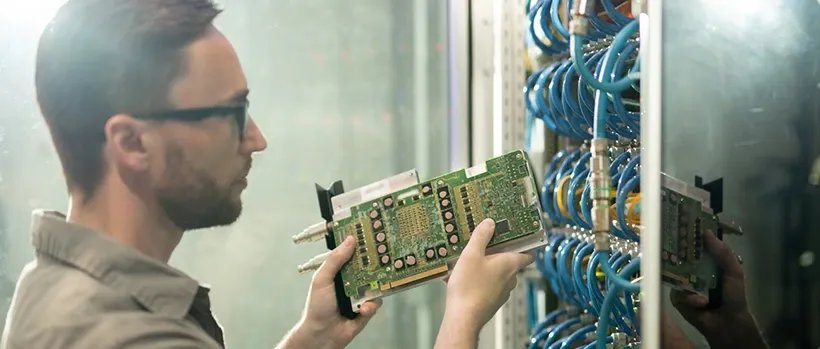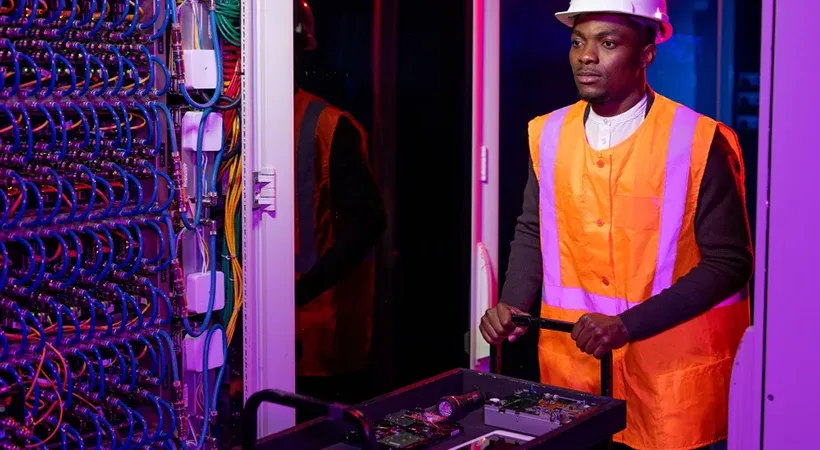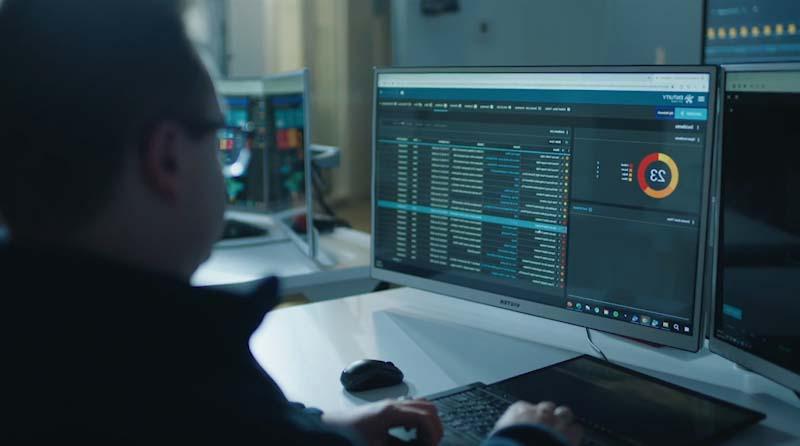What to Do with Old IT Equipment – Servers, Computers, Laptops & More
Park Place Professional Services
Are you an IT professional wondering about the latest IT equipment disposal best practices?
The Information Technology market has become increasingly complex with different pockets of specialization. Sure, you’re a pro at your unique job, but that doesn’t mean you’re an expert at decommissioning IT equipment.
Ensure Data Erasure Standards Are Being Met
Offsite Erasure, Destruction & Recycling
Onsite Erasure, Destruction & Recycling
As an IT professional, you are already aware that your organization handles a lot of sensitive data. Whether it’s data about confidential internal processes or the personally identifiable information of your clients, it’s important that data on your legacy equipment doesn’t fall into the wrong hands.
So, how do IT asset disposition (ITAD) professionals keep your data safe during the computer and server disposal process?
Is it Safe to Recycle Old Computers and Servers?
With the security risks in the market today, you are interested in the secure disposition of IT assets. Reputable companies follow data erasure standards, such as the NIST 800-88 global standard.
At one point in time, the Department of Defense had their own standard called the DoD Information Assurance Certification and Accreditation Process (DIACAP). However, the DoD adopted the NIST standard in 2014 to align governmental and civilian standards toward a “universal” data erasure standard.
The data wipe standards and guidelines set forth by NIST help to ensure civilian and government entities are aligned with the Federal Information Security Management Act (FISMA).
In short, these standards have been deemed acceptable by government agencies, and will likely provide a safe experience when you’re ready to recycle old IT equipment.
Ensure Data Erasure Standards Are Being Met
Following the NIST standard for data wipes can keep you safe and compliant with organizational policy, but it’s up to you to ensure those standards are being followed.
Big arrays generally have onboard utilities from their respective OEM that are designed for a simple data wipe. You may think that calling a rep from the OEM to come in and wipe your data is all that you need to prepare for the disposal of IT equipment, but it’s not wiped to accredited standards.

For example, you may have an EOSL Dell EMC array that you’d like to recycle. If you call Dell, they can send a technician to your premises that will use command line language to engage an onboard utility that overwrites your drives. Functionally, this process is intended to do the same thing as a NIST-accredited wipe, but there is no certificate of erasure, and it will likely fall short of your organization’s security standards.
Therefore, when your enterprise faces a computer or server hardware recycling project, turning to an experienced IT asset disposition company is your best bet. Whether your policy requires onsite or offsite erasure and destruction, the proper accreditation and chain of custody must be followed.
Offsite Erasure, Destruction & Recycling
Whether onsite or offsite, your ITAD partner is still going to use NIST-compliant erasure software. When you send storage and server racks to an offsite destruction facility, you can pull the individual disks from their arrays, or you can leave them intact—the NIST erasure standard can be met either way.
To get started, your team creates a list of your old IT equipment for your ITAD partner. Before leaving your data center, the partner will ensure everything on the list is onboard their vehicles. Once the equipment load has been reconciled with your hardware list, your team will sign equipment releases that can be used to ensure your organizational policies are met.
Onsite Erasure, Destruction & Recycling
Onsite erasure/destruction follows the same standards, but from a cost perspective, offsite destruction is exponentially cheaper.
Onsite wipes and destruction require sending an ITAD tech to your location with the required security appliances and trays in tow to remove your drives. This process is time consuming and expensive.
If your enterprise policy allows for offsite destruction, it will have less of a negative impact on your IT budget.
What to Do Before Disposing of Old IT Hardware
Whether you’re in the process of an IT hardware refresh, data center relocation, data center consolidation, or decommissioning a data center entirely, it pays to have a plan for your old data center components that won’t be used for production.
Before disposing of old computers, servers, and networking equipment, your team must put together a list of assets for decommissioning. The best way to expedite the disposal process is to stick to the asset list you provide to your ITAD partner.
In many organizations, IT Managers, Purchasing, or Finance leaders will order the disposition. IT assets are then collected for disposal and stored somewhere accessible for the disposition team. Between the time of ordering and shipping, it is extremely common for data center techs to scavenge the equipment for drives and memory components that can be used for sparing.
If your ITAD partner arrives for pickup and the assets on your docket don’t match the assets ready to ship, it will take time to adjust the initial order.
Alternatively, if the IT Managers, Purchasing, or Finance leaders that did the ordering underestimated the assets for disposal, your recycling partner will need to spend time adjusting their records for the increased number of assets. This could also require logistical adjustments that are extremely difficult to coordinate on the fly in today’s environment.
What to Do with Old Servers
Servers decline in value way faster than laptops and desktops. The average server that Park Place Technologies’ ITAD team sees is 5-7 years old.
Unfortunately, servers stop having significant value after 3-4 years. If you plan on selling old server equipment that is older than four years, don’t count on recouping much of your asset’s original value.

Whether your assets are being prepped for server disposal or server recycling, they need to be wiped. Erasure security appliances are connected to your asset, and the drives are audited and formatted. If it is discovered that your drives are no longer operable, they will require destruction.
Server Destruction
When your drives can’t be wiped and repurposed, they must be removed for destruction. Your drive serial number is scanned for recordkeeping, and then the physical drives are crushed. A drive crusher punches through the hard disk spindles and ripples the platters. This process makes it impossible to recover data from the hardware.
After the process is complete for each piece of decommissioned server hardware, a certificate of destruction is issued.
Server Recycling
A good ITAD professional can generally determine whether a server can be recycled when your Purchasing, Finance, or IT Manager sends over the list for asset disposition. Once they pass the drive audit, your server components follow the data erasure process and are issued corresponding certificates of erasure. The erased drives are then scheduled for repurposing.
In general, the drives, memory, processors on servers and arrays are taken to their component parts before being repurposed.
What to Do with Old Computers
Laptops and desktops “age” slower than servers and can go around 4-5 years while still retaining some value. To understand how to dispose of old computers, you can simply look above to your old server disposal process.
The same erasure software that is used for servers is used for computers. However, the data erasure software for your desktops and laptops lives on a thumb drive that can be plugged in to execute. If your ITAD partner is following NIST standards, disposing of old laptops securely is no problem.
Computer Disposal
If your computer is prohibitively old, there is a strong chance that it will be scheduled for destruction from the start. However, even laptops and desktops that appear to have resale value could need destroyed if the hard drive audit turns up any bad sectors.
If this is the case, your drive is removed, and its serial number is scanned for recordkeeping purposes. A drive crusher then pierces the hard disk spindles so that the platters are rippled—making it impossible to recover data from your drive.
Once this is done, a certificate of destruction is issued.
In the off chance you’re a consumer worried about the proper disposal of old computers (rather than an enterprise IT professional), OEMs, retailers, or your local recycling company likely host several IT recycling events throughout the year. If you’re wondering—who takes old computer equipment near me?—browse this IT recycling list from the EPA to learn how to safely dispose of old computers.
Computer Recycling
For desktops and laptops that aren’t prohibitively old and pass drive audits, the data erasure process is followed, and subsequent certificates of erasure are issued. The disposal of computer components is different from servers and networking equipment in that laptops and desktops are sold as whole units instead of being broken down to the component levels.
What to Do with Old Networking Equipment
Switches, routers (and sometimes access points) are all examples of old IT equipment that can be securely disposed of by your ITAD partner. You may initially think that network hardware is not like the disposal of computer components, because it doesn’t hold any memory. However, IP addresses are frequently stored on your enterprise networking components.
The data erasure for network devices involves clearing IP addresses (you don’t want to provide a map for bad actors to coordinate a security attack on your network). Once your data has been erased, IT asset disposition experts take the chop shop approach, and supervisor cards and network cards are removed for repurposing and/or resale.
The Right ITAD Partner Keeps Your Organization Secure and Compliant
Park Place Technologies Professional Services is comprised of highly trained field engineers, project managers and system engineers that can help facilitate seamless IT infrastructure support operations to supplement your core team.
Our data center professional services include a specialized group of IT asset disposition professionals that can provide data center storage migration, asset re-deployment, secure off-site or on-site data destruction, hardware recycling and equipment resale.
Contact our team today to learn how we can help with your next ITAD project!



